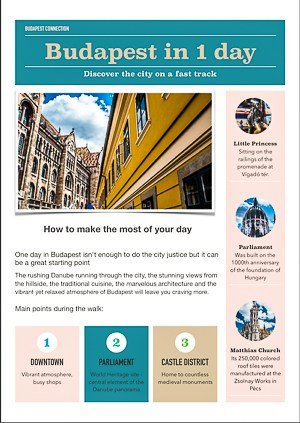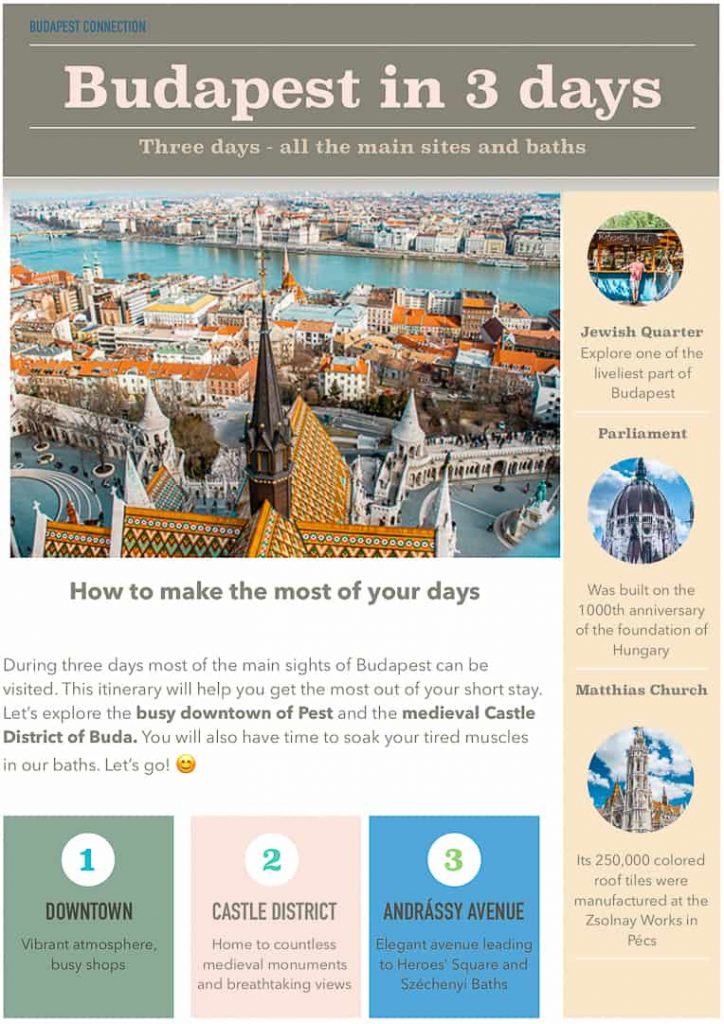Budapest Attractions - what to see in Budapest
Budapest has several attractions that are highly recommended to visit.
If you are trying to plan your Budapest trip, you will quickly realize, that in this beloved city there are so many things to see, so much to experience and so much history in Budapest that it can be hard to know where to begin.
Remains of an ancient Roman Civil Town, Turkish baths, monarchical grandeur, Zsolnay-accented Art Nouveau, Bauhaus and award-winning modern architecture, café culture, quaint Jewish quarter and leafy Buda – just a few examples.
This post will highlight the most important ones to help you to make the most out of your stay.

The city has been called the ‘Paris of the East’ but it’s very much it’s own.
A traveller in the early 20th century wrote:
Budapest is the capital of fascinating history.
Many folks have already lived in and crossed this country, enriching or destroying it (or did both).
Budapest has been demolished several times, lived through world wars, revolution against Habsburg rule by the Austrian Empire in 1848-49 and the against the Soviets in 1956.
Every battle left their mark on the city and some of these marks are left visible to serve us as reminders.
Budapest is also one of the most beautiful city of Europe with numerous attractions and it also has many secrets and hidden gems.
When to Visit Budapest
While life in Budapest certainly goes on regardless of the weather, and the city is beautiful all year round, there are seasons that are more suitable for sightseeing than others.
Summer is the main tourist season, of course, but the weather can be very hot and humid.
During winter Budapest is often gets blanketed with a white sheen of fresh snow, making the city a winter wonderland.
The weeks around Christmas and New Years Eve is also a very popular season for our visitors.
For more about the seasons and their characteristics read my blog post Budapest month by month.
Top Budapest Attractions
Medicinal Baths of Budapest
Budapest has the most medicinal baths among cities.
It is considered to be a “city of water” but the whole territory of Hungary is full of underground medicinal, karst and thermal waters and an entire tourism department has been specialized expressly in medicinal tourism as our waters has several beneficial effects on the human body.
Budapest is the only metropolis in the world that has 123 medical springs and the only one that has 5 historical spas that are still in operation.
Visit any of these and you will realize why Budapest is on the top of medical tourism worldwide.
For more information read my blog post about Budapest Baths.

Széchenyi Baths is the largest spa complex in Budapest and also in Europe.
Its Neo-Baroque building is in contrast with the Buda-side spas’ Orientalist and Ottoman style, while its outdoor pools have forever attracted water-lovers even in the middle of winter, so warm and unique is their thermal water.
It has 21 pools in spectacular surroundings is only the cherry on the cake as its mineral-rich thermal water, coming from 1,246 m below ground, is known to benefit physiotherapy, while another source provides artesian thermal water good for digestive problems.
Open daily from 6:00am to 10:00pm; the thermal bath closes at 7:00pm.
Castle District
The Buda Castle District is an area where you can almost touch history.
It is full of quaint alleyways and cobbled streets.There are remnants of the original medieval settlement, full of tiny houses with Baroque or neo-classicist façades.

It is one of the three World Heritage sites of Budapest for a reason.
Sit at one of the outside tables of Ruswurm café and enjoy its delicious cakes or take them with you and find a bench in front of Matthias Church.
We recommend strudel with poppy seed filling, and “somlói galuska“.

The Buda Castle is home of the Royal Palace that has been destroyed and rebuilt many times during its long history.
The Buda Castle area it is home to the National Gallery, the Castle Museum and Széchenyi Library.
It is a nice walk through the pretty streets as you walk towards the other delicate landmark, the Matthias Church and Fisherman’s Bastion.

Budapest is number 1 when it comes to underground secrets. It has the largest geothermal cave system – right under your feet.
Under the Buda Castle District there is a more than 20 km (12.4 miles) long labyrinth of caves. These caves always had functions during our history. If you would like to experience one of the most interesting usage of them, check out the Hospital in the Rock Nuclear Bunker Museum.
How to get to the Castle District
You can take bus Nr. 16 from Deák Ferenc tér and get off in the Castle District, or you can take Nr. 16 to Clark Ádám tér and ride the funicular to the Royal Palace. You can also walk up the stairs of the Castle District, which will take about 20 minutes.
Jewish Quarter

The Jewish Quarter (the maze of narrow streets behind the Synagogue) is full of narrow streets, passages and hidden courtyards, designer shops and all kinds of bars and restaurants. This unique mix makes this quarter one of the most exciting neighborhoods of Budapest.
Today it is the party center of the city and the walls are full of murals and other kinds of street art.
This is the neighborhood where you can find the Great Synagogue.
The quarter has a huge contrast with it’s crumbling buildings and shiny new apartment blocks, unique monuments and trendy bars.
With several design centers and art galleries in the area, it became a hip place popular among locals and tourists.
Budapest Attractions: Must see buildings in Budapest
Chain Bridge

The Széchenyi Chain Bridge is a suspension bridge that spans the Danube River between Buda and Pest, the western and eastern sides of Budapest and it was also the first permanent bridge.
Designed by the English engineer William Tierney Clark, it opened in 1849 for the public to make trespassing easy between the two parts of the capital.
The true highlights are the lions at the pillars, which are still guarding and watching citizens and visitors.
For more information check out my blog post about Bridges of Budapest.
Great Market Hall

Built between 1897, it was one of the most modern market halls of its time. It’s vendors used a small channel of the Danube to bring their product indoors. It was reconstructed between 1991-94 and the Zsolnay tiles were added this time.
After taking a look at the building from the outside, stroll the market and shop for fresh delicacies.
This is the biggest market hall in Budapest, with fresh food being sold on the main floor and lots of souvenirs on the second floor.
On the upper floor there are also food stalls and a small restaurant.
Here you can try goulash, langos, or sausages (like those on the picture) for example.

Parliament

The Hungarian Parliament building, because it’s an architectural gem and a true feat of engineering. This massive building was built by the famous Hungarian architect Imre Steindl, in a magnificent Gothic Revival style, and it took almost 20 years to complete.
I recommend to take their various guided tours as well as the themed walks offered inside the building, which are full of stunning details.
Inside you can also view Hungary’s most important historical artefact, the Holy Crown, which belonged to Saint Stephen, Hungary’s first Christian king.
St Stephen’s Basilica
Standing in the central area of Budapest where the streets offer the coolest and most popular hangout spots in the city.
Saint Stephen’s Basilica is exactly the same height as another of Budapest’s iconic buildings, the Parliament. And it is intentional, it represents the balance between church and state in Hungary.
The most interesting and valuable relic of Hungary is the right hand of Saint Stephen, who died in 1038. Five years after his death his coffin was reopened and while other parts of his body were perished, his right hand mummified naturally.
Today it is displayed in the largest Catholic Church of Hungary, St. Stephen’s Basilica.
If you are not claustrophobic, climb up (the elevator takes you up until halfway) to it’s panorama terrace because from there the whole downtown will be under your feet and you can also see the Buda mountains.

For detailed information, check out this post:
Matthias Church
Both Matthias Church and the Fisherman’s Bastion were (re)built by the same architect, Frigyes Schulek.
Parts of the church are more than 500 years old, but most of what you can see today was built in 1896, a year that has a very big importance for Budapest’s architecture because it was the year of the Millennium, the celebration of Hungary’s 1000th birthday.
Do not miss to pay attention to it’s details: the stained glass windows, rose windows and the hand painted walls and columns. Visit the Ecclesiastical Art Museum and climb up to its lookout tower.
Check out my blog post for detailed information: Secrets and Stories of Matthias Church
Fisherman’s Bastion
It has 7 turrets, representing the 7 Hungarian tribes who let the Hungarian conquest.
The name comes from the fact that the fish market was just below here in the middle ages and this section of the castle wall was protected by fishermen.
Today it is one of the most popular spot to take photos with it’s fairytale design and breathtaking panorama of the city laying before it’s foot.
Check out my blog post for detailed information: Fisherman’s Bastion
Bridges of Budapest
Bridges play an important role in the daily life of the city.
The Danube has – and always had – a vital role in Budapest’s economy and transportation.
Our bridges connect not only the two sides of Budapest but also hundreds of industries, businesses.
It is fortunate, that they are also very beautiful and unique.

Our bridges also serve as sightseeing points in the middle of the Danube.
For example, from the Chain Bridge, you can see the whole Castle area on your left, while from Margaret Bridge, the Parliament will be on your right, providing perfect photo opportunities. Liberty Bridge is also a favorite spot for those who are looking for a unique place to rest and enjoy a nice view.
Check out my blog post for detailed information: Beautiful Bridges of Budapest
Vajdahunyad Castle
Vajdahunyad Castle – situated in the City Park – is actually a building complex of a museum, a palace and even towers that can be visited.

Originally the complex was called “Historic Building Complex” and it was made from wood and – some parts – cardboards.
Because of its huge success, it was built again from stone because people fell in love with it.
So through the sheer power of human love and appreciation it became a real Castle.
Just like Pinocchio became a real boy.
Great Synagogue of Dohány Street

It is the largest synagogue in Europe, the second largest (after the New York Temple Emanu-El) in the world. It can hold almost 3000 worshipers (1497 men and 1472 women).
The Holocaust Memorial in the back garden, with a graveyard and a metallic weeping willow with the names of those died in the Holocaust.
During the World War II, it was the center of the Jewish Ghetto.
It was built in Moorish style but also has a mix of Byzantine, Romantic and Gothic elements. The onion domes of the twin towers were influenced international design of synagogues.
If you would like to learn more about the synagogue, I recommend taking their guided tour.
Check out my blog posts for detailed information: Jewish District and its street art and Guide to Ruin Bars in Budapest
Gresham Palace
The building was erected by the British Gresham Life Insurance Company.
After its opening in 1907 the Palace was a huge success and its coffeehouse attracted people like a magnet.

It is an outstanding building of the Hungarian secessionist architecture. Its wall tiles, walling and flooring were designed and made by the Zsolnay factory.
It was renovated between 1999 and 2004 and now it is the most beautiful and luxurious hotel in Budapest.
The hotel’s design embodies historic grandeur and youthful exuberance, combines regal splendor with comfort.
This hotel is very popular among Hollywood stars and it is also a filming location.
Even if you’re not staying in this luxury hotel, take a peek inside. Its a good glimpse at how the upper class lives. 🙂
Budapest Attractions: Streets, squares and parks
Margaret Island
A 2,5 km long island in the middle of the Danube.
In the middle ages it was an important religious center. It is named after St. Margaret, the daughter of King Béla IV, who dented her to god in exchange for the help to get rid of the invading Mongols.
Today it is a popular recreational area with swimming pools and other sport facilities.
It has also a small zoo, a music fountain and a Japanese Garden with goldfish.
You can rent quirky pedal and motorized carts.
For more info check out my post: Best things to do on Margaret Island

Castle Garden
Do not leave the Castle area without visiting the Castle Garden. Anywhere you look it is beautiful. You can see the Royal Palace, the Gellért Hill – topped with the Citadel and the Statue of Liberty – and the Parliament from one spot. There are several benches where you can have a rest while enjoying the view. It is also a great picnic spot.

Gellért Hill
Gellért Hill is a 140-m high dolomite rock, topped by the fortress of Citadel and the Statue of Liberty, rising above the Danube in Buda. A popular excursion spot in Budapest with wonderful view to the whole city.


Gül Baba and the Rose Garden
The final resting place of Gul Baba, Muslim dervish and member of the Bektashi order who died right after the capture of Buda in 1541.
This is the northernmost Islam sacred place.

Normafa
A popular hiking spot in the Buda Hills. You can walk along it’s several forest trails, hike up to the Elisabeth Lookout tower, eat strudels and drink tea (or mulled wine during winter) at a buffet. There is also a great playground here.
The view of the city from it’s slopes is gorgeous.
It is an all-year-round, easily and quickly accessible spot, always full of families, couples, runners and dog walkers.
A great place to escape the buzz of the big city that lays at it’s feet.

Andrássy Avenue
Andrássy Avenue connects the city to Heroes’ Square and City Park.
It was built in time for the 1896 Millennium celebrations and was one of the most successful achievement of the city development programs. The avenue became fashionable immediately.
There are several interesting spots along this boulevard such as the Opera House (currently under reconstruction), House of Terror Museum, House of Hungarian Photography.
Underneath it runs the European continent’s first, still functional underground, the Millenium underground.
Erzsébet Square
Very easy to find this square, it’s right in the middle of downtown Budapest and there is a huge Ferris Wheel called Budapest Eye here. It that can be seen from a distance.
In front of the Budapest Eye is a beautiful fountain that has an interesting history. The figure of a man represents the Danube, while the three women below symbolize three tributaries of the Danube.
The fountain used to be somewhere else but after it was seriously damaged during World War II, it was placed in this park after it was repaired.
One of the oddest things of Budapest can be found here, too.

City Park
The whole area used to be a meadow and popular hunting area for noblemen.
It was turned into a public park in the early 19th century.
Along with Heroes’ Square right in front of it, it used to be the main venue of the 1896 Millennium Celebrations.
It’s attractions include: Vajdahunyad Castle, the Budapest Zoo, Széchenyi Bath and Városliget Lake.
Danube Promenade
The promenade stretches between Elizabeth Bridge to Chain Bridge on the Pest side of the Danube. It has a beautiful view of Buda Castle and the bridges.

Tram line 2 runs along the promenade.
You can also take a boat trip from the middle of the Promenade, Vigadó Square, where the Vigadó Concert Hall stands.
There are some cute statues here:
Tourists particularly like the statue of the Little Princess sitting on the railings of Danube Promenade. This statue was made by a father who made her daughter’s dream to become a princess timeless. According to it’s legend, if you rub the statue’s knee, you will be lucky in self-fulfillment.
Váci Street
A pedestrian street in the heart of the city, between Vörösmarty Square and the Great Market Hall. It is one of the oldest streets of Pest.
Today it is famous for it’s shops, (overpriced) restaurants, (not recommended) night clubs and souvenir shops.
The shops are mostly international ones such as Zara, Mango, H&M, Desigual.
It is a very popular spot among tourists but Hungarians also shop here.

Fashion Street
A shopping street with exclusive international brands, between Vörösmarty Square and Deák Square.

Szabadság Square
A spacious square not far from the Parliament building and the St. Stephen’s Basilica.
It was laid out in 1886 on the spot of the former Neugebäude (New Building), a fortress-like buildings where the first prime minister of Hungary, Lajos Batthyány was executed by the Austrians for his role in the 1848-49 revolution.
The huge memorial in the middle of the square is the Memorial of the Russian Army who helped to kick the Nazis out of here (without any intention of leaving afterwards).
There is an another monument standing on the opposite side of the square, the Memorial to the Victims of the German Invasion. The memorial seems to honor those who died at the hands of the Nazi’s. Something we should never forget.
Ronald Reagan is here, too. 🙂

Grand Boulevard
If you walked from one end to the other namely from Petőfi Bridge to Margaret Bridge, it would take about two hours.
The Boulevard is surrounded by beautiful buildings, but many of them has seen better days.
Walking along it you can get a true insight into Budapest and its everyday life.

Ráday Street
From spring to fall this street is packed with terraces of bars and restaurants. The first restaurant that received a Michelin Star in Budapest, Costes, is located here, just a few steps away from Kálvin Square.
The street has a great, laid back atmosphere.

Király street
Located in the middle of the Jewish Quarter and is also known as the Design Street, as it is full of interior design stores, boutiques and art galleries.
It became a trendy part of Budapest, an always buzzing spot, hub of parties with it’s endless eateries and bars.
Worth visiting day and night.

Heroes' Square
If you think that you have already seen Heroes’ Square before even stepping to Hungary, you may be right. It has already been to videos and films such as a Michael Jackson video or “Evita”. It is the largest square in Budapest.
The 36 meter high pillar in the center is called the Millennium Monument as it was also built for the celebration of Hungary’s 1000th birthday. Archangel Gabriel stands at the top of the monument, holding the holy crown and the double cross of Christianity.
The seven leaders of the Hungarian tribes who founded modern Hungary are represented semicircular around the Monument.
The square is beautiful during daytime, but the most beautiful at sunset and when it is already lit. It is a popular meeting spot so you don’t need to afraid of loneliness anytime.
The square is the entrance to the City Park, where you find the Széchenyi Baths, the Vajdahunyad Castle, the Zoo and Europe’s largest outdoor ice rink during the winter months or a paddle lake during summer.
How to get there
Széchenyi Baths, Heroes’ Square and City Park are accessible by Metro 1 from Deák Ferenc tér, at Hősök tere stop.
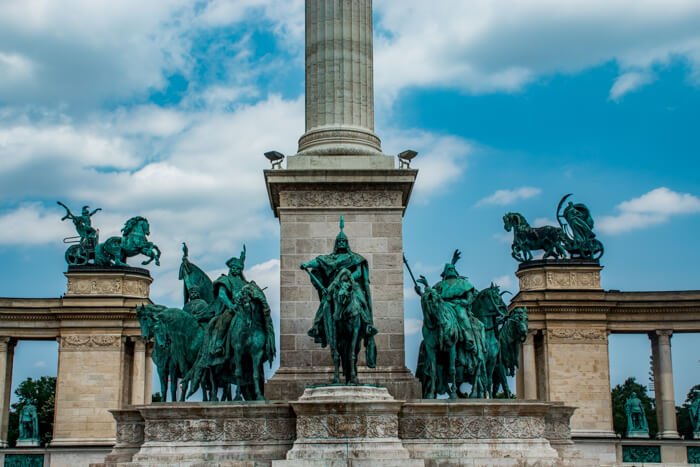
Palace Quarter
Walk around the Palace Quarter to see luxurious mansions built between 1860 and 1900. Some of them are being renovated, some of them are waiting for it.

Károlyi Garden
This French-style, family-friendly public park is the oldest garden in Budapest.
Ideal place for relax in the middle of downtown. Grab a drink at Csendes, at the park’s gate.

Our tips
1. The most socio-culturally diverse district to explore - the 8th district
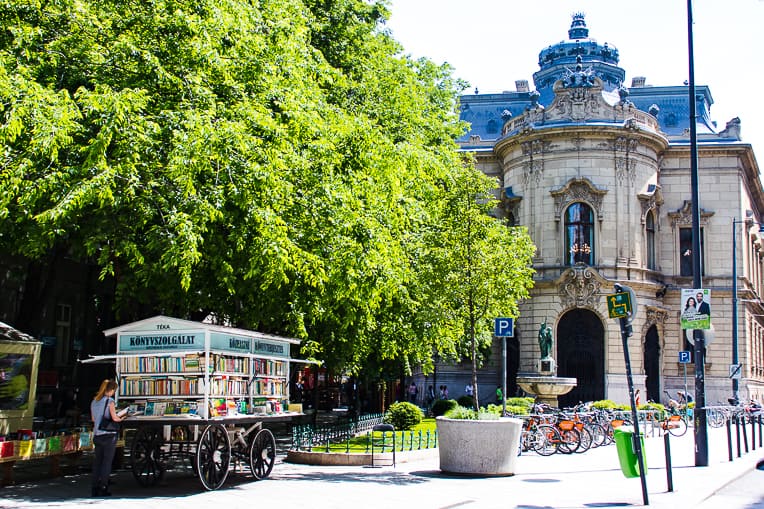
There is no other district in Budapest that has more contrast than the 8th district, also called as Józsefváros.
Here you find luxurious mansions, residences and streets that are worn by the rigors of time and slummy areas.
Also traces of history are clearly visible here such as bullet holes from the 1956 revolution and battle-scarred buildings from the WWII.
2. The best district to explore if you are interested both in history and today’s trends -Jewish Quarter
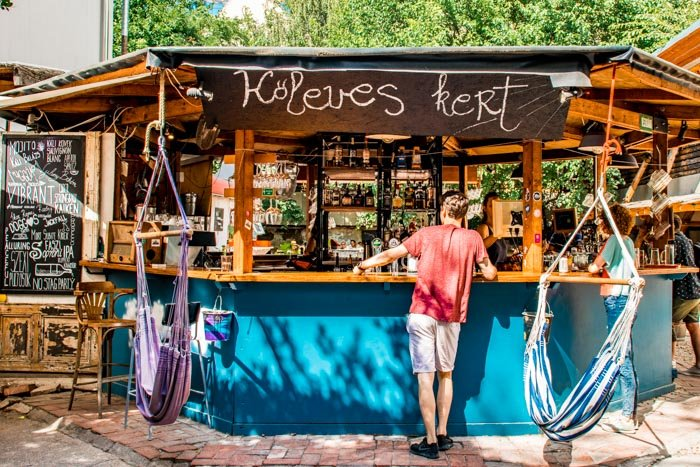
The Jewish Quarter is one of the most hipster area of Budapest today.
Full of unique bars (also famous ruin bars such as Szimpla Kert, Kőleves), cafés and design centers, art galleries, with all the street art, it is a great place to spend at least a few hours, half a day.
3. Architectural Style to admire - Hungarian Art Nouveau

“New Art” was a popular style of architecture between 1890 and 1910. In Hungary it was quite popular, the architects who designed buildings were inspired by traditional Hungarian decorations and folk art, Transylvanian and even Far East styles and patterns.
Look at the facades of Gellért Spa, the Geological Institute, Gresham Palace for example.
You can also visit the House of Art Nouveau, a 3 story building just a few steps away from the Parliament.
4. Best place to watch the sunset
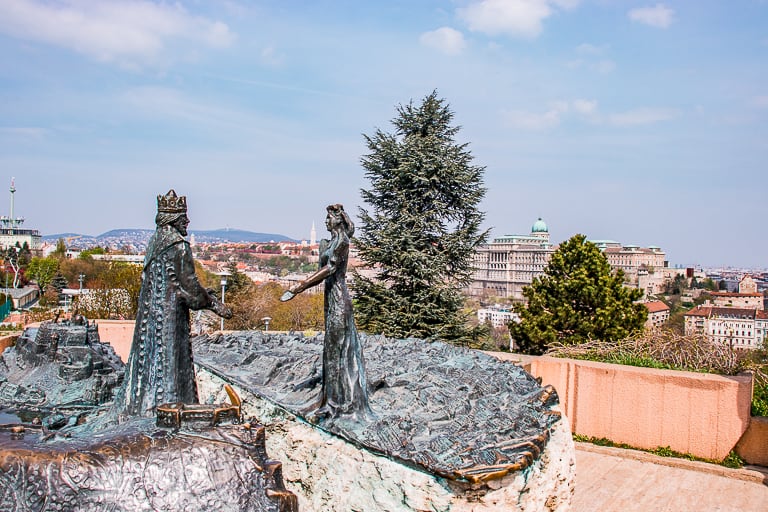
There is a cute little park on the northern side of Gellért Hill that is somehow unknown even from most Budapest residents.
Here you find not only the Garden of Philosophers and the statue of Prince Pest and Princess of Buda, but a very unique spot to see the whole city right in front of you.
Just sit on the stone walls surrounding the lookout point, grab a sandwich and something to drink and enjoy the view as the sunset colors the sky to orange and pink and as the lights are starting to lit up on the public streets and in people’s homes.
As you can see Budapest is full of attractions that are waiting to be discovered.
Even better that many of them are free or cheap to visit. Be sure to check out as many as you can while you are here! 🙂
If you need some more help with planning your trip, check out my itineraries:
If you would like to play to find out what kind of traveler you are, check out my quiz! It will give you a list of thing you should visit in Budapest according your result. Have fun! 😊
If you liked this post, please share it with your friends and if you have any questions, write a comment below!
Have a great time in Budapest! 😊
Pin Now, Read Later. Save This Post on Pinterest.
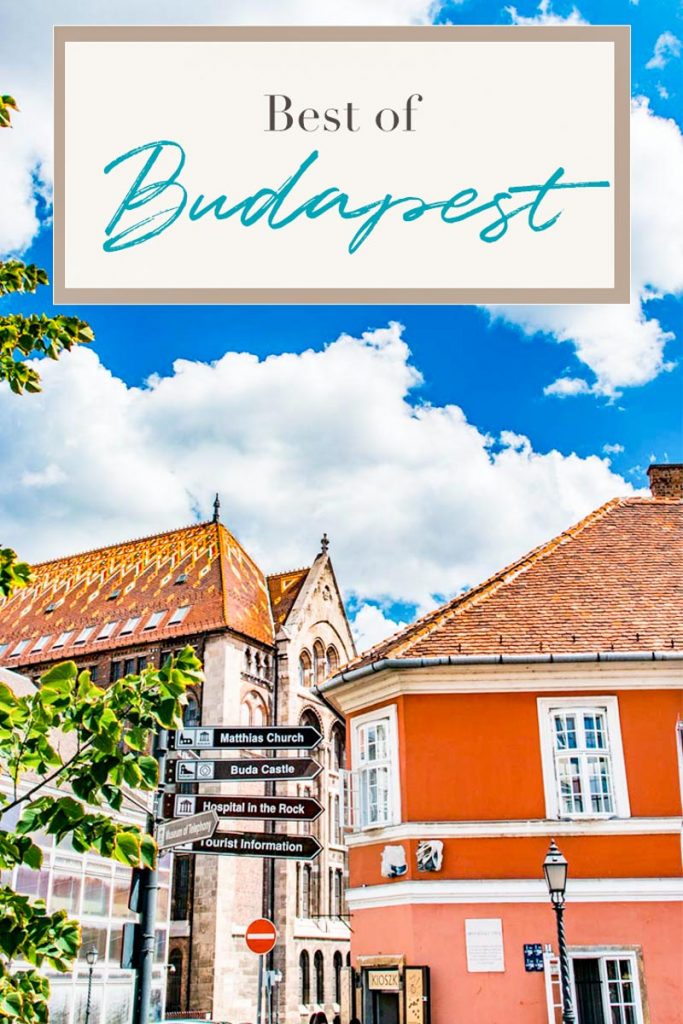
You might be interested in these

